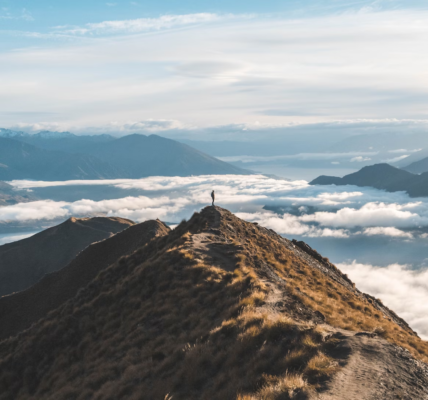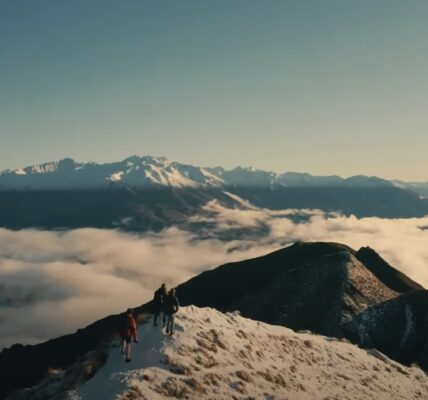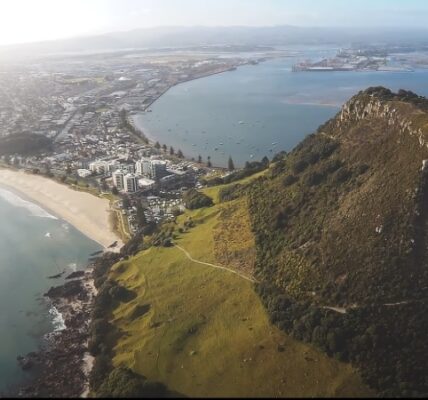Mt Cook, also known as Aoraki, stands as a towering sentinel in New Zealand’s landscape, captivating visitors with its majestic presence and challenging trails. This article delves into the towering heights of Mt Cook, explores its location, and traverses its popular walking paths, providing a detailed guide for enthusiasts and tourists alike.
The Stature of Mt Cook: How Tall is the Mountain?
Mt Cook, the highest mountain in New Zealand, reaches a sky-piercing elevation of 3,724 meters (12,218 feet). Its grandeur not only dominates the Southern Alps but also holds a revered place in both Maori culture and the heart of mountaineers. Here’s a quick overview of Mt Cook’s dimensions:
| Attribute | Details |
|---|---|
| Height | 3,724 meters (12,218 feet) |
| Location | Southern Alps, South Island, New Zealand |
| First Ascent | December 25, 1894 by Tom Fyfe, George Graham, and Jack Clarke |
Pinpointing the Giant: Where is Mount Cook Located?
Nestled in the rugged Southern Alps of New Zealand’s South Island, Mt Cook is not just a natural wonder but also the centerpiece of the Aoraki/Mount Cook National Park. The park itself is a part of the Te Wahipounamu World Heritage area, highlighting its global significance and natural beauty. Here’s how to locate Mt Cook:
Geographical Location
Mount Cook, also known as Aoraki, is nestled in the rugged Southern Alps of New Zealand’s South Island. It stands as a beacon of natural wonder and serves as the centerpiece of the Aoraki/Mount Cook National Park. This park is not only a testament to the awe-inspiring beauty of New Zealand’s landscapes but also holds significant global importance as part of the Te Wahipounamu World Heritage area.
- Region: Mount Cook is located in the Canterbury region of the South Island;
- Nearest Towns: The nearest town to Mount Cook is Twizel, offering essential services and amenities for visitors. Other nearby towns include Lake Tekapo and Wanaka, which also provide access to the mountain and offer alternative routes for travelers;
- Accessibility: Despite its remote location, Mount Cook is easily accessible by road. It is approximately 322 km (200 miles) from Christchurch, the largest city in the South Island, and about 256 km (159 miles) from Queenstown, another major tourist hub. These distances can be covered by car, providing travelers with a scenic drive through the picturesque landscapes of the South Island.
Nearest Towns
Several towns serve as gateways to Mount Cook and play a vital role in facilitating visitors’ experiences.
- Twizel: Situated closest to Mount Cook, Twizel offers a range of accommodation options, restaurants, and outdoor activities for visitors. It serves as a convenient base for exploring the surrounding area;
- Lake Tekapo: Renowned for its stunning turquoise lake and picturesque Church of the Good Shepherd, Lake Tekapo is another popular town near Mount Cook. Visitors can enjoy various recreational activities such as stargazing, hot springs, and hiking;
- Wanaka: Located to the west of Mount Cook, Wanaka is a charming town known for its scenic beauty and outdoor adventures. It offers a relaxed atmosphere and is an ideal stopover for travelers en route to Mount Cook.
Accessibility
Despite its remote location amidst the Southern Alps, Mount Cook is surprisingly accessible by road.
- Distance from Christchurch: Approximately 322 km (200 miles) from Christchurch, the journey to Mount Cook from this city takes travelers through diverse landscapes, including lush farmland, rolling hills, and eventually the dramatic peaks of the Southern Alps;
- Distance from Queenstown: Approximately 256 km (159 miles) from Queenstown, the adventure capital of New Zealand, Mount Cook is easily accessible for travelers seeking an adrenaline-filled journey through the scenic landscapes of the South Island.
Scenic Route
The journey to Mount Cook is as much a part of the experience as the destination itself. Travelers embarking on this adventure are treated to a scenic drive through some of New Zealand’s most picturesque landscapes.
- Iconic Lookouts: Along the route to Mount Cook, several iconic lookouts provide panoramic views of the surrounding mountains, glaciers, and lakes. Notable viewpoints include the Lake Pukaki lookout, which offers stunning vistas of the turquoise waters of the lake against the backdrop of Mount Cook, and the famous Peter’s Lookout, renowned for its breathtaking views of Aoraki/Mount Cook and the Tasman Glacier;
- Natural Beauty: The journey offers glimpses of New Zealand’s diverse natural beauty, from lush forests and crystal-clear lakes to towering peaks and cascading waterfalls. Travelers have the opportunity to stop at various points along the way to soak in the scenery and capture memorable photographs.
Traversing the Trails: Popular Mt Cook Walks
Mt Cook is not only famous for its height but also for the variety of walking tracks that offer both amateur hikers and seasoned trekkers unforgettable experiences. Whether you’re looking for a short walk or a full-day adventure, Mt Cook has something to offer. Here are some of the most popular Mt Cook walks:
Hooker Valley Track
The Hooker Valley Track stands out as one of the most popular and accessible walking trails in the Mt Cook region. Stretching over 10 kilometers round trip, this track offers a moderate hiking experience suitable for adventurers of all ages and skill levels.
- Swing bridges: Traverse picturesque swing bridges that span over alpine streams, providing a thrilling experience while offering safe passage over the water;
- Alpine streams: Immerse yourself in the tranquility of alpine streams fed by glacial meltwaters, offering a serene ambiance amidst the rugged terrain;
- Stunning view of Mt Cook: Reap the rewards of your journey with stunning panoramic views of the towering peak of Mt Cook, creating an awe-inspiring backdrop for your adventure.
The relatively flat terrain of the Hooker Valley Track makes it ideal for families and casual hikers, allowing them to soak in the breathtaking beauty of the Southern Alps without strenuous exertion.
Kea Point Walk
The Kea Point Walk presents a shorter yet equally captivating hiking experience, spanning a distance of 3 kilometers round trip. Despite its brevity, this trail boasts unmatched panoramic views of Mt Cook and the sprawling Mueller Glacier. Marvel at the expansive vistas that showcase the majestic beauty of Mt Cook and the surrounding glaciers. Perfect for those craving a leisurely stroll amidst awe-inspiring scenery, the Kea Point Walk offers a chance to reconnect with nature while admiring the rugged grandeur of the Southern Alps.
Sealy Tarns Track
For the more adventurous hiker, the Sealy Tarns Track presents a thrilling challenge, spanning a distance of 5.8 kilometers round trip. This track is characterized by its steep ascent, offering a test of endurance rewarded with breathtaking views.
- Steep climb: Embark on a challenging ascent through subalpine vegetation, pushing your limits as you make your way towards the summit;
- Spectacular alpine tarns: Discover hidden alpine tarns nestled amidst the rocky landscape, providing a tranquil oasis amidst the rugged terrain;
- Views of the Hooker Valley: Pause to catch your breath and marvel at the sweeping vistas of the Hooker Valley and surrounding peaks, offering a sense of accomplishment amidst the awe-inspiring beauty of the Southern Alps.
Mount Cook’s Geographical Significance

Situated within the Pacific Ring of Fire, Mt Cook’s dramatic landscape is a testament to the powerful forces of tectonic activity and glacial erosion that have shaped the region over millions of years.
Tectonic Uplift and Formation
Mt Cook, also known as Aoraki in Māori, stands as the tallest peak in New Zealand, soaring to an impressive elevation of 3,724 meters (12,218 feet) above sea level. This majestic mountain is predominantly composed of granite, a resilient igneous rock formed deep within the Earth’s crust. Its genesis can be attributed to the collision of tectonic plates along the boundary of the Pacific and Australian Plates.
- Uplift Mechanism: The uplift of the Southern Alps, including Mt Cook, is a consequence of the ongoing convergence between the Pacific and Australian Plates. Subduction of the Pacific Plate beneath the Australian Plate induces intense pressure and heat within the Earth’s crust, resulting in the uplift of the mountain range;
- Plate Tectonics: The tectonic activity along the Pacific Ring of Fire has led to the formation of numerous mountain ranges, volcanoes, and geological features around the Pacific Ocean basin. Mt Cook’s towering presence is a testament to the dynamic nature of Earth’s lithosphere.
Glacial Sculpting
The landscape surrounding Mt Cook bears the unmistakable signature of glacial activity, shaped by the relentless advance and retreat of glaciers over millennia. Glaciers, massive rivers of ice, have played a pivotal role in sculpting the rugged terrain of the region.
- Erosive Power: The Tasman Glacier, New Zealand’s longest glacier, originates from the slopes of Mt Cook, carving its way through the rugged landscape as it descends towards the Tasman Valley. The erosive force of glacial ice has left behind a legacy of U-shaped valleys, hanging valleys, and distinctive landforms characteristic of glaciated landscapes;
- Moraines and Cirques: Glacial activity has deposited vast quantities of rock debris, known as moraines, along the valley floors and sides. Cirques, or bowl-shaped depressions, mark the beginnings of glaciers, where snow accumulates and compacts into ice, initiating the glacial flow downstream.
Dynamic Weather Patterns
The area surrounding Mt Cook is renowned for its dynamic and unpredictable weather patterns, influenced by the mountain’s elevation and proximity to the Tasman Sea. These atmospheric phenomena contribute to the ever-changing character of the landscape.
- Microclimate: Mt Cook’s elevation and geographic location create a unique microclimate characterized by rapid fluctuations in temperature, wind, and precipitation. Clear skies can swiftly give way to swirling mists and low-hanging clouds, enveloping the peaks in an ethereal veil;
- Photographic Opportunities: The interplay of light and shadow, accentuated by dynamic weather conditions, provides photographers with a wealth of opportunities to capture the dramatic beauty of the landscape. From sunrise to sunset, the changing hues of the mountainscapes create mesmerizing compositions that evoke a sense of wonder and awe.
Conservation Efforts and Cultural Heritage
Conservation efforts within Mt Cook/Aoraki National Park are dedicated to safeguarding its distinctive biodiversity and cultural legacy, with a particular emphasis on the preservation of indigenous flora and fauna, as well as the cultural heritage of the Ngāi Tahu tribe, the traditional custodians of the region. Collaborative initiatives between conservation organizations and local iwi (tribes) are instrumental in maintaining the ecological and cultural integrity of this iconic landscape.
Preservation of Flora and Fauna
The unique ecosystems of Mt Cook/Aoraki National Park harbor a diverse array of indigenous plant and animal species, many of which are endemic to the region. Conservation efforts are directed towards protecting these species and their habitats from threats such as invasive species, habitat loss, and climate change.
- Habitat Restoration: Conservation projects focus on restoring and enhancing the natural habitats within the park, including wetlands, forests, and alpine meadows. These efforts involve activities such as revegetation, pest control, and erosion control measures to promote the recovery of native flora and fauna populations;
- Species Recovery Programs: Endangered species within the park, such as the kea (Nestor notabilis), New Zealand’s native alpine parrot, receive special attention through targeted conservation programs. These initiatives aim to address key threats to kea populations, including predation, habitat destruction, and human disturbance, to ensure the long-term survival of this iconic species.
Cultural Heritage Preservation
The cultural heritage of the Ngāi Tahu tribe, whose ancestral lands encompass the area surrounding Mt Cook/Aoraki, is deeply intertwined with the landscape and natural resources of the region. Conservation efforts seek to honor and protect this rich cultural heritage through collaboration with local iwi and the incorporation of traditional knowledge and practices into park management strategies.
- Cultural Interpretation and Education: Interpretive programs and educational initiatives within the park provide visitors with insights into the cultural significance of the land to the Ngāi Tahu people. Guided tours, storytelling sessions, and cultural performances offer opportunities for visitors to learn about the traditional customs, stories, and spiritual connections associated with the landscape;
- Partnerships with Local Iwi: Collaborative partnerships between conservation agencies and local iwi play a vital role in shaping the management and stewardship of Mt Cook/Aoraki National Park. These partnerships foster mutual respect, understanding, and shared decision-making processes, ensuring that conservation efforts are aligned with the cultural values and aspirations of the Ngāi Tahu people.
Conclusion
Mt Cook, a symbol of natural splendor, challenges and beckons climbers and hikers from around the world. From understanding how tall is Mt Cook to exploring where is Mount Cook and walking the famed Mt Cook walk, this mountain offers more than just a physical journey—it’s a voyage through the heart of New Zealand’s natural heritage. Whether you are a seasoned hiker or a casual tourist, the trails and tales of Mt Cook promise an adventure of a lifetime.
FAQ
Mt Cook’s elevation is 3,724 meters (12,218 feet), making it the highest mountain in New Zealand.
Mount Cook is situated in the Southern Alps of New Zealand’s South Island, within the Aoraki/Mount Cook National Park.
Popular walks at Mt Cook include the Hooker Valley Track, Kea Point Walk, and the Sealy Tarns Track, each offering unique views and physical challenges.
Yes, the region around Mt Cook is famous for its glaciers, with the Hooker Glacier being a prominent one that can be viewed from the Hooker Valley Track.
Yes, there are several trails, such as the Kea Point Walk, that are suitable for beginners. However, the mountainous terrain also offers challenges for more experienced adventurers.







